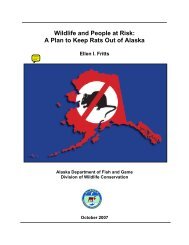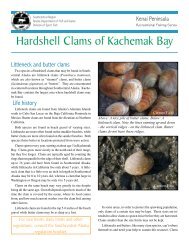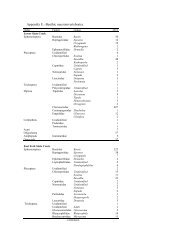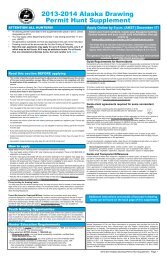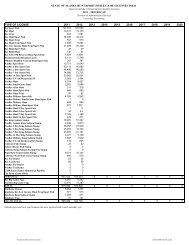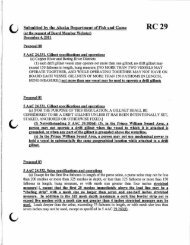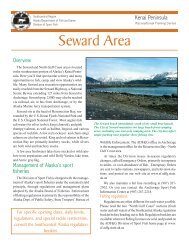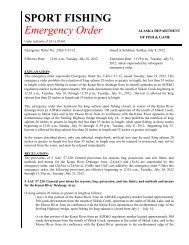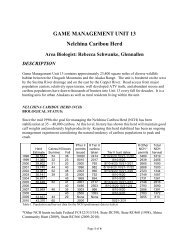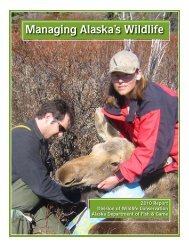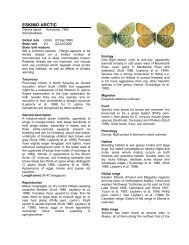fishery management report no. 12–46 - Alaska Department of Fish ...
fishery management report no. 12–46 - Alaska Department of Fish ...
fishery management report no. 12–46 - Alaska Department of Fish ...
You also want an ePaper? Increase the reach of your titles
YUMPU automatically turns print PDFs into web optimized ePapers that Google loves.
the lakes in the TRMA, with the exception <strong>of</strong> the Tolovana drainage and Harding Lake, to June<br />
1–April 20.<br />
Current or Recommended Research and Management Activities<br />
Northern pike populations should continue to be monitored in George and Volkmar lakes to<br />
assess possible fisheries impacts from the recent regulation changes.<br />
Other TRMA Northern Pike <strong>Fish</strong>eries<br />
Harding Lake is located about 45 road miles southeast <strong>of</strong> Fairbanks along the Richardson<br />
Highway and is the largest roadside lake <strong>no</strong>rth <strong>of</strong> the <strong>Alaska</strong> Range (Figure 3). Northern pike<br />
were a high-pr<strong>of</strong>ile game fish in Harding Lake because they were readily caught, and their<br />
preference for shallow water habitats made them highly vulnerable to anglers. In 2000, <strong>no</strong>rthern<br />
pike fishing at Harding Lake was closed due to low abundance; for details about the closure and<br />
habitat rehabilitation efforts see Brase (2009c).<br />
Northern pike are common in many smaller lakes and in sloughs, and tributaries <strong>of</strong> the Tanana<br />
River, and small harvests are <strong>report</strong>ed annually from many locations throughout the TRMA. The<br />
Lower Chena, Zitziana, and Salcha rivers; Piledriver Slough; and gravel pits in south Fairbanks<br />
and on Eielson Air Force Base are examples <strong>of</strong> the types <strong>of</strong> areas that produce <strong>no</strong>rthern pike for<br />
anglers. Other fisheries occur in lakes in the Kantishna River drainage (such as East Twin and<br />
Mucha lakes) and in clear boat-accessible sloughs, backwaters, and small tributaries <strong>of</strong>f <strong>of</strong> the<br />
Tanana River. Other lakes in the Upper Tanana River drainage with <strong>no</strong>rthern pike populations<br />
are Sand, “T”, Mansfield, Dog, Island, Tetlin, Takomahto, Jatahmund, Island, and American<br />
Wellesley lakes.<br />
The <strong>no</strong>rthern pike present in the Tanana River drainage provide the population reservoir which,<br />
through the movements <strong>of</strong> individual fish, ensures continued viability <strong>of</strong> small stocks and<br />
availability <strong>of</strong> fishing opportunity wherever suitable habitat occurs, including colonization <strong>of</strong><br />
ponds. Northern pike colonize suitable gravel pits and other ponds when the river floods into<br />
them and the pits become connected to the river, or when people illegally introduce <strong>no</strong>rthern pike<br />
into those waters. Many <strong>of</strong> these areas are road-accessible and rarely produce large numbers <strong>of</strong><br />
fish or many large fish. It is <strong>no</strong>t presently possible to develop a direct estimate <strong>of</strong> effort because<br />
<strong>of</strong> the mixed-stock fisheries <strong>of</strong> which these <strong>no</strong>rthern pike fisheries are a part.<br />
The wide range <strong>of</strong> accessibility for anglers and the diversity <strong>of</strong> types <strong>of</strong> angling opportunity add<br />
value to these fisheries. Angler interest in road-accessible <strong>no</strong>rthern pike fisheries is high.<br />
However, the nature <strong>of</strong> <strong>no</strong>rthern pike as a piscivore that takes the hook readily, but requires<br />
many years to grow to the larger sizes valued by anglers, makes it difficult to manage <strong>no</strong>rthern<br />
pike fisheries in roadside situations.<br />
Abundance, and age and sex composition, studies were conducted in East Twin Lake in 1993<br />
(Pearse 1994) and Deadman Lake in 1994 (Hansen and Pearse 1995). In both cases, populations<br />
were judged to be healthy and capable <strong>of</strong> sustaining existing harvest levels. A radiotelemetry<br />
study done in 1993 and 1994 in the Chena River suggested that adult <strong>no</strong>rthern pike in that river<br />
move little during the year (Pearse 1994).<br />
Providing harvest opportunity at sustainable levels is an overriding <strong>management</strong> responsibility.<br />
However, in roadside ponds stocked with salmonids, such as rainbow trout, and where <strong>no</strong>rthern<br />
25




